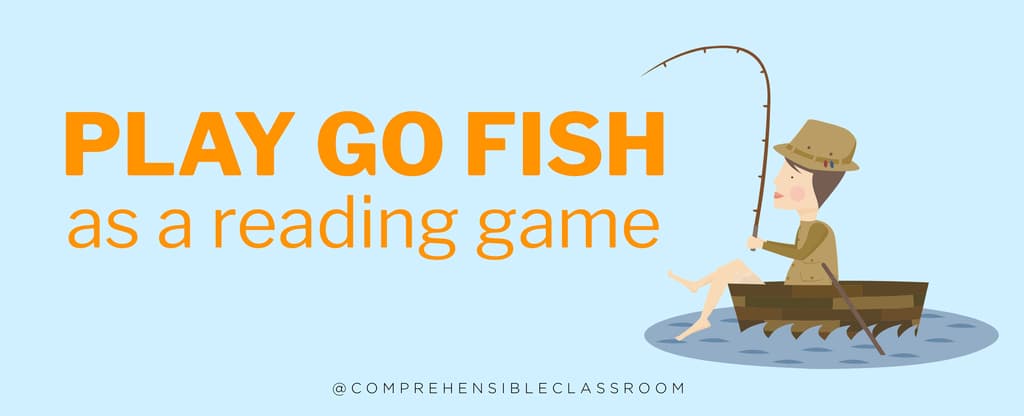
Instead of playing with a deck of cards, play this familiar children’s game with original cards filled with images or text as an opportunity to to get students speaking in low-risk situation even as they continue interacting with a text ('cause it's all about the input, baby!).
Before you play Go Fish
Prepare students for this output activity by pre-loading them with comprehensible input. The activity will be most successful and beneficial if students are very familiar with the scenes that they will be describing. Some basic ideas for providing input are storyasking and MovieTalk; you can also tell familiar stories or classic fables to students--even current events stories! Reading the stories once you have shared them with students orally will further support their success in an output activity, as the story will be that much more familiar to them.
How to make Go Fish cards for your language classes
There are lots of different kinds of cards that you can create for your classes depending on the kind of content that you want students to be working with and whether you want this activity to stay all about the input or whether you want to use it to gently nudge students into the productive mode.
Here are some different card types that you can create:
- Images depicting scenes from a short film, story, or novel--preferably a familiar piece of content. The images should not be ambiguous--it should be very clear what is happening in the depicted scene. Also, students should be VERY comfortable describing the scenes before you ask them to produce a description on their own. For a short film, use MovieTalk and then read the story of the film before playing Go Fish! Alternatively, you can include some images and some TL descriptions in the deck, forcing students to consider both meaning (image) and text as they sort through their hand to find a match. See the Carrot Crazy screen shot sample set below.
- Sentences in the target language. These can come from a text or from a story, or they can just be random sentences. To mix things up, include some TL sentences and some translations--students will have to consider both languages as they look through the cards in their hand to find matches.
- Quotes or possible quotes from familiar characters–instead of exact matches, students must match unique quotes that were said or could have been said by the same character.
- Mix up sentences from different stories. Students must read the events in their hand and decide which story it comes from, then ask the other players if they have events from that story!
- List basic vocabulary or numbers instead of story scenes...but since we can further acquisition by keeping the cards in context, it's worth it!
- Create 12-15 cards.
- Print four copies of the set of images in order to make a single deck of playing cards (remember that a typical deck has 52 cards, or 4 sets of 13). Use card stock to make the game more durable, and consider laminating it if you want to use it again in the future.
- Form groups of 2-4 students and have them play “Go Fish!” in the target language. (In Spanish, "Go fish!" is "¡A pescar!".)
*If you are combining text and image or L1 and target language, you'll need to create more cards and make fewer copies to create a deck. For example, you'd need to choose 13 scenes and then create 26 cards from them--13 scene descriptions in Spanish and 13 in English. Then make two copies of the 26 cards to get a full deck of 52 cards.
How to play Go Fish in a language class
- For 2 players, each player starts with 7 cards; 3 players start with 6 cards each; 4 players start with 5 cards each. The remaining cards go face down in the “fish pond” (draw pile).
- For complete instructions for game play, see http://www.gofish-cardgame.com.
- Instead of asking “Does anyone have a #?”, students should ask (in the target language), “Does anyone have a picture of when [scene description]?” For example, “Does anyone have a picture of when [the boy makes a carrot cake]?”
Support student success by writing the correct TL expression for "Do you have...?" on the board!
Other ways to use your Go Fish cards
Once you've created the cards for this game, you can use them for zillions of other activities.
- Have students line up the scenes on their desks, then close their eyes while a partner removes one of them. The student must describe what happened in the missing scene.
- Tape one scene to each student’s forehead. The student must ask yes/no questions about his/her scene to his/her classmates until s/he correctly determines which scene is on his or her own forehead.
- Distribute one card to each student, then have them silently form a human timeline.
- Use them for a speaking or writing assessment: give several scenes to a student, and have them describe what is happening.
See a sample set of cards
As an example, check out the free set of cards that I created using screen shots from the short film “Carrot Crazy”. The film is one of my favorite to use with MovieTalk, and it is available on YouTube (click here). Please be aware that there are weapons depicted in the film, so use your discretion when showing it in class. I did not include any of those images in the card deck.
Learn more about the role of output
For more on the role of output in comprehension based language classes, please read this post.





